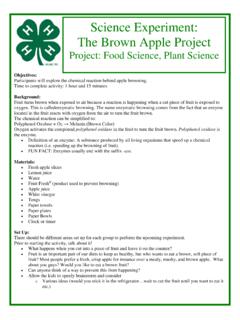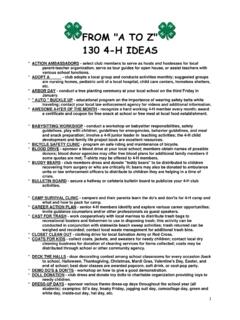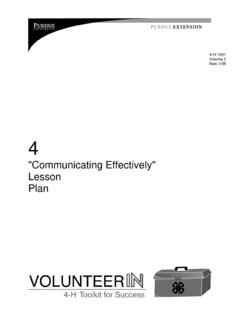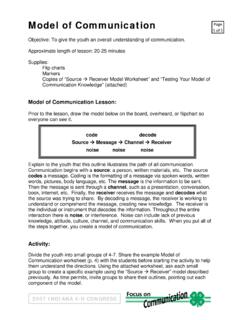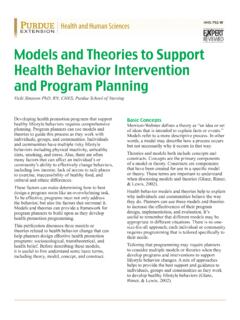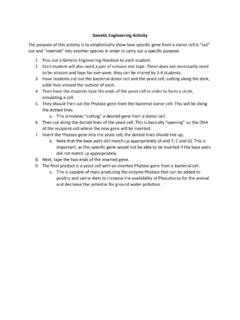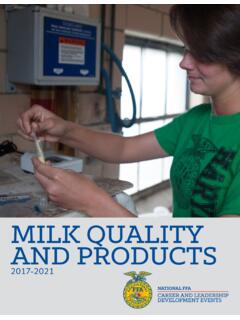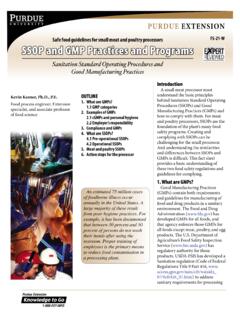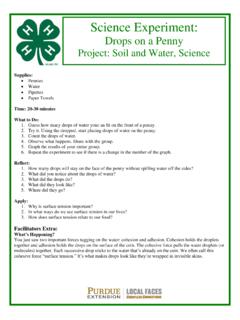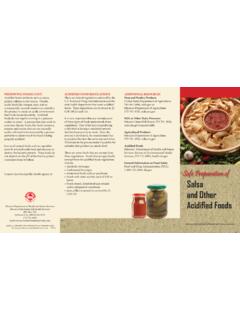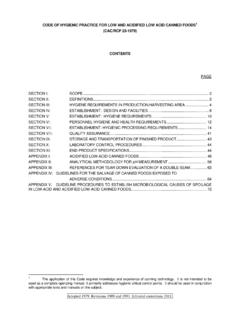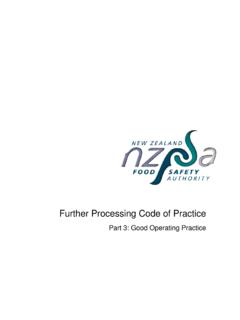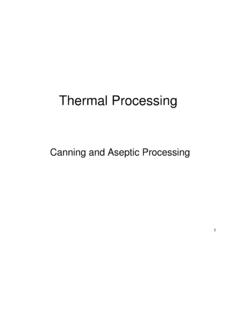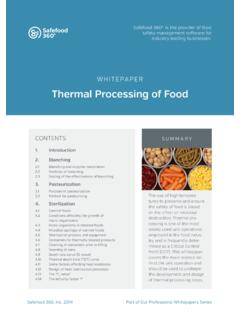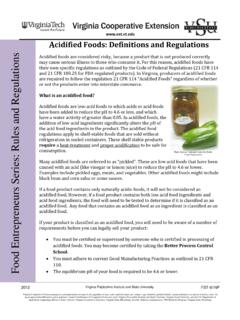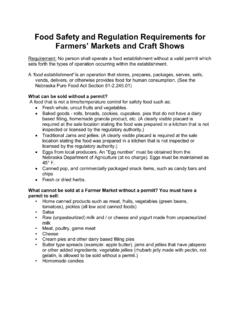Transcription of Basics of Home Canning - Home - Purdue Extension
1 1 HHS-799-WHealth and Human SciencesBasics of home CanningLET S PRESERVEC anning can be a fun and economical way to make fresh foods available year-round. Don t take chances with Canning recipes handed down over the years. Use procedures that have been scientifically tested to ensure safe and high-quality canned products and optimized for prolonged storage. Use this fact sheet to understand the correct procedures for Canning foods at two safe methods of Canning food at home are boiling water bath Canning and pressure Canning . Whether a food is high acid or low acid indicates what type of processing method should be used (Table 1). Generally, high- acid foods can be safely canned in a boiling water bath. Low- acid foods must be processed in a pressure 1.
2 Examples of low- acid and high- acid foods and required processing Foods Pressure CanningHigh- acid FoodsBoiling Water Bath CanningMost vegetablesMost fruitsAsparagusApples and apple sauceBeets ApricotsCarrotsBerriesGreen and dried beansCherriesOkraGrapesPeasJams and jellies (fruit only)PeppersPeaches and nectarinesPotatoesPearsPumpkinPie fillings (fruit only)Sweet corn PlumsMeatsAcidified and fermented foodsBeef and PoultryChutneysMincemeat pie fillingPickled vegetablesSeafoodPickles (cucumbers)Wild gameRelishesCombination FoodsSalsa Meat saucesSauerkrautSoups and stewsTomatoes (acidified)**Directions are available for boiling water bath and pressure Canning of home CanningLET S PRESERVEA cidity in FoodsLow- acid FoodsLow- acid foods include meats and vegetables (except for acidified tomatoes and pickled products).
3 Low- acid foods lack the acidity needed to inhibit the growth of bacteria and spores that can survive the temperature of boiling water (212 F). The bacterium of greatest concern in home Canning is Clostridium botulinum because it can produce spores that generate a dangerous toxin that causes food poisoning. Botulism spores thrive on low- acid foods in the absence of air, in the presence of moisture, and at room temperature the conditions inside a jar of home - canned meat or vegetables. While spores of Clostridium botulinum may survive a boiling water bath, they are destroyed when processed in a pressure canner where the temperature can reach 240 F or FoodsMost fruits have naturally high levels of acid . While tomatoes have some natural acids, they are borderline between high and low acid and need bottled lemon juice, citric acid , or vinegar (labeled 5 percent acidity) to increase their acidity for safe food processing.
4 Fermented foods, such as sauerkraut, and foods to which a sufficient amount of vinegar is added, as in pickled vegetables, are also canned as high- acid foods. Jams and jellies are high- acid foods unless low- acid vegetables, such as peppers, are added. Foods in the high- acid category can be safely processed by the boiling water method. Consult other Let s Preserve fact sheets for details about Canning specific Water ProcessingHeat is transferred to the food by the boiling water that surrounds the jar. Maintaining a temperature of 212 F for the time specified in an approved recipe is adequate to destroy molds, yeasts, enzymes, and some bacteria. Processing times are usually given for altitudes under 1,000 feet above sea level. At higher altitudes water boils at lower temperatures, making it necessary to process foods Pressure ProcessingWhen heat is applied to a sealed canner, pressure builds up inside that canner.
5 Water inside the canner forms steam, which replaces air. When the vents are closed, only pressurized steam hotter than boiling water remains in the ProceduresSelecting Jars and LidsMason jars are recommended for home Canning . Commercial single-use jars are less likely to seal and may break, especially in a pressure canner. Lids may not fit single-use jars. Canning jars come in a variety of sizes. Most recipes have been developed for pint and quart jars. If processing times are not specified for smaller jars, process them the same as the next larger size that is specified. Half-gallon jars are recommended only for Canning apple and grape juices. If properly used, jars may be have been research tested using standard Mason jars. Many specialty shops sell novelty jars in different sizes and shapes.
6 Unusual jar shapes may not work with process times and temperatures given in the Let s Preserve fact recommended lid consists of a flat metal disc that has a sealing compound around the outer edge and a separate metal screw band. The lid should not be reused; the bands may be reused as long as they don t rust. Never reuse lids from commercially canned foods for home food preservation. Zinc lids or bail-type jars with rubber rings are no longer recommended for home Pack or Raw PackWhen foods are raw packed the jars are filled with freshly prepared, unheated food . Raw-packed foods will often float in the jars, and the air trapped in and around the food may cause discoloration within 2 to 3 months of storage. Hot packing involves heating freshly prepared food to boiling, simmering it briefly, and promptly filling the jars loosely with the boiled food and liquid.
7 Hot packing helps remove air from inside the food tissues, shrinks the food , and helps keep the food from floating in the jars. Preshrinking that occurs in hot packing allows more food to fit into each Canning Guidelines Use tested recipes from Penn State Extension s Let s Preserve fact sheets, the USDA Complete Guide to home Canning , So Easy to Preserve (University of Georgia), or the Ball Blue Book. All these contain research based recipes. All should be 1994 or more recent editions. Older recipes may not have adequate processing times or pressure for safety. Use Mason jars because they withstand the higher temperatures of a pressure canner better than single-use jars. Use proper headspace: inch for juices, jams and jellies, and relishes; inch for fruits, tomatoes, and pickles; 1 to 1 inches for meats and vegetables.
8 Refer to a tested recipe. Too much headspace results in a lower vacuum and a weak seal. Too little head-space may force food under the lid, causing siphoning 3 Basics of home CanningLET S PRESERVEor breaking of the seal. Remove air bubbles with a plastic utensil. Wipe edge of jar with a clean, damp paper towel. Use two-piece lids (a new flat disk and a screw band). Only tighten lids finger-tip tight. Use a jar lifter to place jars into canner and to remove jars. Be careful not to tilt jars. Process according to the boiling water bath or pres-sure Canning procedures that follow. Adjust process times or pressure for altitudes that are 1,000 feet or more above sea level. After processing, set jars at least 2 inches apart to cool. Do not retighten bands.
9 Do not turn jars upside Water Bath Procedures Follow all the practices listed under General Canning Guidelines above. Fill the canner about half full with water. Preheat water to 140 F for raw-packed foods and to 180 F for hot-packed foods. Place jars on a rack in canner. Add more water if necessary to cover jars with at least 1 inch of water. Place the lid on the canner and keep covered during processing. Turn heat to its highest position until water boils vigorously; then lower heat setting to maintain a gentle boil while processing. After processing for the designated time, turn heat off, set off burner, remove lid, and let jars rest in the canner for five minutes before removing from the canner this will reduce siphoning (loss of liquid from the jar).
10 Pressure Canning Procedures Follow all the practices listed under General Canning Guidelines above. Put 2 to 3 inches of water in the bottom of the pres-sure canner. Place filled jars on a rack at bottom of the canner. Heat to boiling to exhaust steam from the canner for 10 minutes before adding the weight or closing the petcock. Add weight or pressure regulator. Allow pressure to rise and maintain at level called for in the tested recipe by adjusting the heat. If pressure goes below recommended pressure at any time during processing, reset your timer to zero and restart the process time. After processing, remove canner from heat and allow canner to cool naturally to 0 pounds pressure. Wait 2 minutes and remove weighted gauge or pressure regulator.
